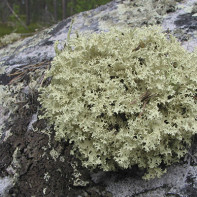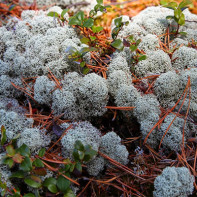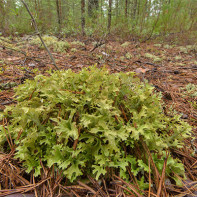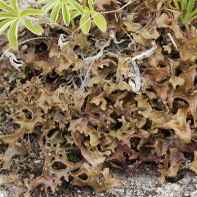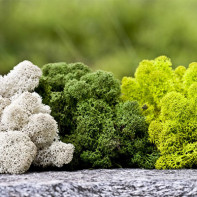Icelandic moss: medicinal properties and contraindications
The year 1918 was raging in Russia, the civil war. The situation with food throughout the country was extremely difficult, there was a catastrophic shortage of bread, especially in large cities. In Moscow a way out of this difficult situation was found in an unexpected place - the city pharmacies, warehouses which were filled with Icelandic moss. It was immediately put into action: it was soaked in a solution of soda, which removed the bitterness, dried and ground to a powder. It was mixed in equal proportions with rye flour and bread was baked from this mixture. This method of baking bread was borrowed from the inhabitants of the Far North. Thus, thanks to the Icelandic moss, thousands of lives were saved from starvation in the capital.
- Chemical composition
- How it looks and where it grows
- Gathering and storage
- Therapeutic properties of Icelandic moss
- For Women
- For Men
- In Pregnancy
- For children
- For weight loss
- Icelandic moss in folk medicine
- For diabetes
- For pancreatitis
- For gastritis
- For coughs
- For tuberculosis
- Allergies
- For constipation
- For asthma
- For colds
- From sore throat
- Outbreak of maxillary sinusitis
- For prostatitis
- For worms
- Cystitis
- Kinds of medicinal compositions
- Infusion
- Infusion
- Decoction
- Tea
- Salve
- Syrup
- Pharmaceutical preparations with Icelandic moss
- Cosmetic applications
- Wraps
- Elixir for Youth
- For blackheads
- For Dandruff
- Cleansing soap
- Contraindications for use
Chemical Composition
Icelandic moss is also called bread moss, Icelandic lichen, prickly moss, dry-bottomed moss, spatula, lung moss, although the exact name given to it by botanists sounds like cetraria Icelandica. This plant is quite well known, as they began to learn and use it accordingly not one hundred years ago. In northern Europe even at the end of the XVII century began to apply extracts from Icelandic moss as an anti-inflammatory agent for the treatment of wounds.
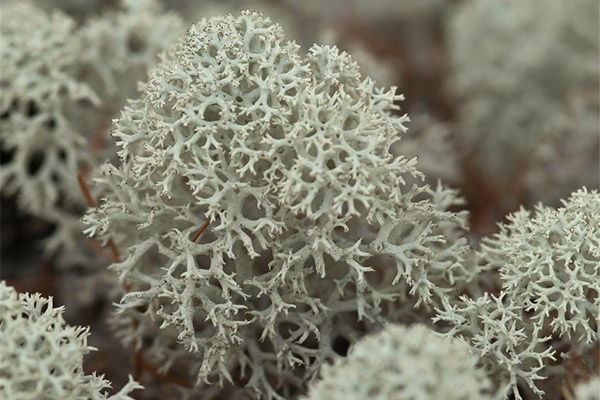
Antiseptic properties of the plant gives it a component such as a sodium salt of usninic acid (or sodium usninate). In addition, the composition of Icelandic moss has a number of acids with high ability to fight microbes - lycheesterinic, protolycheesterinic, fumarprotocenteric and a small number of others. They are excellent against streptococci, staphylococci and other microbes, have a tonic effect, but also give the plant a bitter taste.
Approximately 70-80% of the chemical composition of Icelandic moss are carbohydrates, mostly polysaccharide lichenin, which has the ability to form glucose on contact with water, and islichenin. In addition, among the carbohydrates contained in cetraria are monosaccharides: glucose and galactose.
Icelandic moss contains ascorbic acid (vitamin C), and in a form that allows the human body easily absorb it. This property of the plant was also used two centuries ago. In addition, cetraria has a crystalline organic compound naphthoquinone (Juglone), which has fungicidal and antibiotic properties. It also contains a small amount (about 0.5-2%) of proteins, fats, wax, and 3% of pigments and gum, which chemists call soft fiber, which can cleanse the body of toxins and detoxes and have a beneficial effect on the digestive system.
What it looks like and where it grows
Icelandic moss is not actually a moss at all. It is a typical representative of lichens in the family Parmeliaceae. Like all lichens, it is not a single organism, but a product of the inseparable coexistence of two types of plant organisms - fungi and algae. Botanists call this union symbiosis.
The base of the plant is an intertwining of filaments of fungi. On the surface, they are intertwined densely, and in the lower layers, more loosely. In these layers, algae are localized between the filaments of the fungus. It appears as if the algae cells are wrapped in mushroom threads. Thanks to this close connection, the fungus and the algae feed each other: the former provides the latter with water and mineral salts, while the latter receives organic carbohydrates in return.
Accordingly, the lichen acquires the power of two organisms in the struggle for existence, which helps it survive in such conditions that are unthinkable for other plants. That's why Icelandic moss grows on barren sandy soils and dunes, naked rocks, bark of old trees. Neither strong winds nor harsh natural conditions resist it.
From the name it is clear that the first evidence of the plant appeared in Iceland, which along with northern Scotland, Wales and southwestern Ireland is its main habitat. But it is also found in the pine forests, forest-tundra swamps and tundras of Europe, Asia, Africa and Australia. In Russia it is most commonly found in the European part of the country, but its colonies are also not uncommon in the Altai and Sayan mountains, the Far East and the slopes of the Caucasus range. It is in Iceland that this lichen can cover the entire territory with solid thickets, while in other places of the planet it usually grows in separate islands-curtins or even single specimens. The plant grows slowly, over the years, and with the necessary prerequisite - clean air and the total absence of factory emissions.
The body of Icelandic moss, like all lichens, is called a stratum. By its appearance, it is impossible to determine where one organ ends and another begins, as in other plants. For example, in grasses, the boundaries between stem and leaf or stem and color are quite distinct. This cannot be said about cetraria. Externally the entire plant resembles a low (no more than 10-15 cm) shrub consisting of flat branches, like blades of greenish-brown or brown. These lobes are slightly bent upwards, irregularly lenticular in shape, very soft to the touch, but quite elastic, leathery-cartilaginous in structure. If you use your imagination to look at the plant, it is easy to see that Icelandic moss looks a lot like heavily branched deer antlers - but in miniature. At the very ends of these "horns" in the saucer-shaped fruiting bodies, spores form. The horns can be both matte and shiny.
The lower part of the stratum adjacent to the soil, rock, and tree trunk is much lighter, ranging from light brown with white spots to almost white in color. Small tears are observed on it, and air flows freely through them.
Gathering and storage
Icelandic moss is harvested in summer on dry, warm days. The follicles are usually simply torn off the base to which they are attached, a good selection of all debris, and then dried. It is better, of course, to do this in a dryer, but another place will do, perhaps even just outdoors if the weather permits. It is a well-dried stratum that is suitable for further use. If you smell it, you can catch a slight smell with a slight bitter hint, and dried Icelandic moss tastes the same.
When the raw material dries, it is placed in cardboard boxes, wooden boxes with paper on the bottom, wicker boxes or dry jars. Take away packaging in a dark, dry and cool place. In these conditions, store it for no more than two years.
Determine how good dried material is not difficult: you just need to pour a small piece of it with cool water. Moss swells up pretty quickly, turns bright green and begins to emit a pleasant forest aroma. To the touch the same piece of moss should become slightly slippery, and cooked decoction begins to resemble jelly.
Therapeutic properties of Icelandic moss
Folk medicine has been using Icelandic moss for several centuries, it is known from treatises in Norway, Sweden, Iceland, where it was widely used to treat colds and coughs. It was used to strengthen the body, treat wounds and burns.
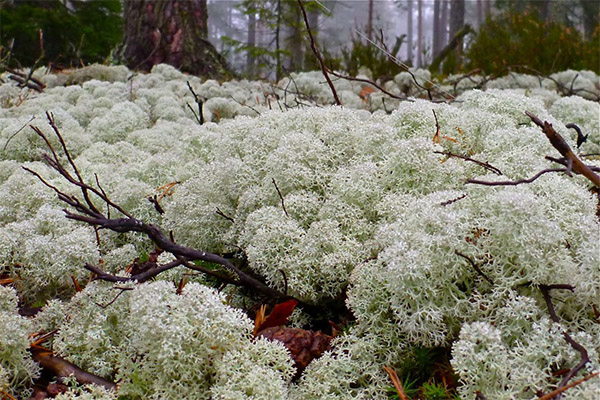
The scientific study of the plant's potential fell in the 1940s of the XX century. It was at that time that the main active ingredients were established, making cetraria a full participant in the treatment process. And the first discovery of physicians and pharmacists were the antibiotic abilities of the lichen.
During the Great Patriotic War, there were several hospitals where cetraria was used to treat gangrene, and very successfully. Covering gangrenous wounds with the moss saved many soldiers' lives.
Today, cetraria is included in the pharmacopoeia of many countries, including Russia.
The first place is given to its ability to cope with serious bronchopulmonary diseases thanks to the proteins, lipids and volatile components that have analgesic, expectorant and soothing effects.
The next sought-after properties of Icelandic moss are healing and regenerative. This is due to the healing mucus, of which the plant consists of 70%. Due to the fact that cetraria contains a large amount of cetraric and usninic acids, it has antimicrobial and regenerative abilities, can reduce the activity and even accelerate the death of cancer cells by inhibiting the enzymes that promote their reproduction.
Lichen is endowed with a pronounced anti-inflammatory effect due to the presence of the polysaccharide lichenin. In addition, it has powerful immunomodulatory and anti-viral properties and is a strong antioxidant that inhibits the process of cell oxidation and premature aging. Tannins and trace elements give the plant a stimulating and hemostatic effect.
Due to such a rich arsenal of components, physicians have learned to use Icelandic moss to combat a whole range of respiratory and nasopharyngeal diseases, including infectious and viral: laryngitis and pneumonia, bronchial asthma and maxillary sinusitis, bronchitis and tuberculosis.
Treat lichen and diseases of the gastrointestinal tract, biliary tract, intestinal infections, diarrhea, avitaminosis. It helps people with nervous exhaustion, weakened after surgery and serious illness, as well as those suffering from skin diseases such as psoriasis, eczema, and various types of dermatitis.
For women
Women always want to be beautiful and slender. That is why most of them are interested in cetraria-based products as an aid in losing weight or solving any cosmetic problems, which the plant copes well with. In fact, Icelandic moss has a more profound effect on the female body, as it is involved in the fine-tuning of the endocrine system.
Also the healing lichen is able to fight mastopathy and toxicosis. It is noticed that the use of decoctions of moss during breastfeeding increases lactation.
As a natural antibiotic Icelandic moss can be used by women to get rid of bacterial inflammation of the vagina and urinary tract.
For Men
One of the components of Icelandic moss - usninic acid, which is called a powerful natural antibiotic, effectively copes with problems of the genitourinary tract. Its effect succumbs to the bacteria that are the causative agents of such infections. Herbalists have noticed that decoction of lichen in combination with lemon mint herb (lemon balm) helps in the treatment of male diseases - prostatitis and prostate adenoma.
When pregnant
Preparations based on cetraria are not contraindicated for pregnant women, because it does not contain dangerous, poisonous or harmful components that could harm the health of the baby. Moreover, expectant mothers, after getting sick with angina or catching a cold, prefer to pharmacy synthetic antibiotics the natural compound, which is lichen. It also works gentler and grew in environmentally friendly areas. But the dosage of drugs and folk remedies should be slightly reduced.
The only thing to take care of - do not self-medicate. It is necessary to consult a doctor, because every disease during pregnancy should be under the control of doctors. There is one more note - an individual intolerance to cetraria is possible.
For children
History knows examples when entire nations used Icelandic moss to care for infants - it was used as diapers. Thanks to the antiseptic properties of the lichen, babies grew up healthy and did not know what a diaper rash was.
Today, preparations and remedies based on Icelandic moss are mainly used to treat whooping cough, bronchitis and cold cough in children of all ages. It is not recommended only for children under one year old, and for the rest you can safely make decoctions and give coughs. Since decoctions of this plant are bitter, children need to add honey to them. It is better to prepare healing compositions not on water, but on milk or kefir, to soften the taste.
For example, if you mix with a blender a glass of kefir, 2 spoons of honey and the same amount of dry medicinal raw materials, the child will not be capricious and refuse to take the medicine: it tastes good. Also for children are suitable syrups based on lichen: they drink the sweet medicine with pleasure, and the benefits from it are incredible.
In addition, moss-based compositions for children treat scratches, wounds, abrasions, burns, various rashes.
When losing weight
The ability of cetraria to speed up metabolism and trigger metabolic processes is used when taking remedies on its basis for weight loss. With a good metabolism fat has no chance to be deposited somewhere in the sides or buttocks. Most effective in this case will work kissel, prepared from this plant.
To prepare it, pre-moist soak overnight in salt water, so that the salt has removed the bitterness from it. For 5 liters of water you need 3 spoons of salt. In the morning, the water is drained, 2 cups of well water and half a cup of moss are mixed in a saucepan and put on the fire. On the stove, boil this mixture for a long time until the moss loses its structure and the contents of the pot becomes homogeneous. Cool it down and drink it 30 ml once a day.
Naturally, it is not possible to lose weight by taking lichen alone. It is impossible to do without athletic training and the organization of a proper diet. But Icelandic moss is completely on the side of those who want to lose weight: it will help to moderate the craving for sweets, reduce edema. Accordingly, it will become easier to engage in physical exercises, which will lead to the purification of the lungs, and this will trigger the desire to increase sports activity. If you follow all the points of this plan, then already in a month you can see in the mirror striking changes, because moss allows you to lose from 5 to 10 kg in this period.
In addition to drinking lichen kissel, you can add the crushed plant directly to your food. Even a small pinch a day is enough to start the fat burning process.
You can also take a decoction prepared in the following proportion: a tablespoon of moss for half a liter of water. Boil for half an hour, strain, cool. Drink half an hour before a meal in the morning and evening in a glass. But tinctures, like alcohol-containing preparations, are not recommended for weight loss.
Icelandic moss in folk medicine
The tradition of using Icelandic moss for medicinal purposes dates back to the XVII century. At that time there were no antibiotics and other powerful drugs, and pharmacists in Iceland and Denmark already used it for coughs and digestive system problems.
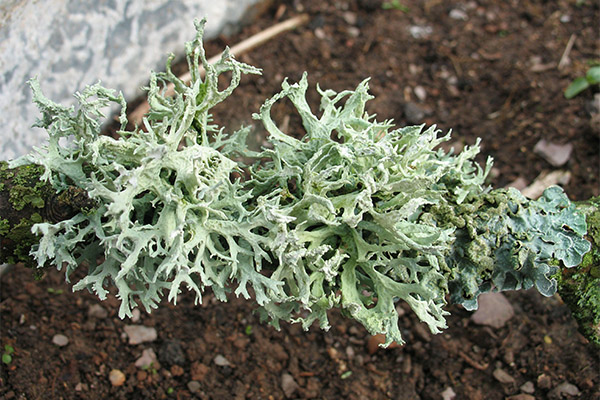
Closer attention and a careful study of the lichen's action allowed folk healers to discover its amazing properties, including the ability to cope with tuberculosis, or, as it was then called, consumption, from which there was still no escape. Since then, recipes for healing potions have been carefully preserved by veduns and passed on to their disciples. To this day, folk medicine considers cetraria one of the most useful plants.
The mucous decoction obtained by boiling the lichen can be used to treat literally all systems of the body - from the respiratory and digestive to the urogenital, from getting rid of trivial runny nose or diarrhea to solving the most complex problems such as tuberculosis, oncology, pneumonia, asthma. It also successfully copes with wounds, burns, purulent boils on the skin.
In addition to healing tasks, Icelandic moss is used by folk healers and for preventive purposes: it strengthens the body, gives him strength, improves immunity. It is especially useful for emaciated, weakened people.
Diabetes mellitus
Studies conducted by scientists in Yakutia show that the people who for hundreds of years have always used Icelandic moss have never had diabetes.
Researchers explain this phenomenon by the lichen's ability to remove from the body not only poisons and heavy metal salts, but also cholesterol and excess glucose. For those who live far from the place where Icelandic moss grows and therefore weaned from its presence in the daily diet, it is important that it not only helps reduce blood sugar, but also has a diuretic effect. And this is essential for diabetics, because in this way edema is reduced, blood flow is improved, respectively the risk of formation of trophic leg ulcers characteristic of this disease is reduced.
Those who have such ulcers formed, lichen will help to heal them and reduce the risk of getting into these wounds streptococcal or staphylococcal infection.
In pancreatitis.
It is possible to use cetraria preparations in the complex treatment of chronic pancreatitis, but you should not do this in moments of exacerbation of the disease. It is useful to use the remedy as a prophylactic composition, especially in cases where the synthesis of gastric juice is reduced.
To prepare such a remedy, mix 1 tablespoon of dry lichen in 250 ml of kefir, add 1 teaspoon of honey, stir well again and let stand for 15 minutes. Drink the composition during dinner. It helps to improve not only the pancreas, but also the microflora of the intestine and liver.
When pancreatitis is complicated, stones can form in the pancreas. Doctors call this condition pancreolithiasis. It is characterized by severe shingling pain in the abdominal area that feels both blunt and sharp. It can, as patients usually say, "recoil" to the right or left side or even to the lower back.
The infusion of Icelandic moss can be used to break up stones. For this, a few spoonfuls of dry raw materials are poured into a glass of apple cider vinegar, stirred and left to infuse in a cool, dark place for two days. Take the infusion before bedtime, diluting 1 teaspoon of the remedy in a glass of water.
With gastritis
Icelandic moss effortlessly helps with problems with the work of the digestive system, diseases of the gastrointestinal tract. To do this, you can use both traditional decoctions of the plant, and delicious breakfasts on its basis, which should be taken in courses of 30-40 days. In prepared compositions, the inherent bitterness of the lichen is not felt.
- Muesli with cetraria. In 1 kg of ordinary store muesli (you can take any, to which you are accustomed and what you like) added a cup of dried and ground in a blender medicinal raw materials are mixed. Each morning, a portion of this mixture pour either milk or cream or ryazhenka and eat for breakfast.
- Yogurt with cetraria. To prepare healing yogurt, a tablespoon of Icelandic moss is placed in a glass of kefir, stirred and waited for 5 minutes. The useful product is ready. You can add 1 teaspoon of honey or five-minute jam from blueberries, currants - will be generally very tasty! Drink in the evening, about an hour before bedtime. By the way, this remedy, in addition to improving the pancreas, will also help in losing weight.
From coughs
Compounds from coughs are prepared both from one Icelandic moss, and combine it with other herbs.
- Cough medicine. Prepare it in an enamel kettle, which pour a glass of milk. Put on a low heat and pour 1 tablespoon of dry medicinal lichen raw materials. Half an hour the mixture is kept on the stove, covered with a saucer or plate (metal lid is not recommended), stirring if necessary. Take the composition hot, before going to bed, drinking 2-3 sips.
- Compound with thyme. Take just a little (about half a teaspoon each) lichen and thyme, pour 250 ml of steep boiling water. This composition infused for 5 minutes, then strain and drink 3 times a day by the glass.
- With the addition of honey. Pour 200 ml of cold water into a pot and pour 2 tablespoons of dried moss, bring to a boil and keep on low heat for an hour. By the end of this time, the contents of the pot should be similar to kissel. To make the composition not bitter, add 1 tablespoon of honey. Drink the ready medication warm, 2-3 sips. During the day you need to drink all the prepared portion.
With tuberculosis
With such a serious and dangerous disease as tuberculosis, compositions based on Icelandic moss can not only relieve a strong debilitating cough, but also have a restorative effect, support the immune system. However, these remedies can only be used as supplementary and in full compliance with the doctor's prescription.
- In a coffee grinder or blender, dry raw materials are made into a powder, take 30 g and pour boiled water (250 ml). Next 5-10 minutes simmer the mixture on a small flame burner. Remove from the stove, cover tightly with a lid, you can even cover the top with a towel for more heat. Insist for half an hour. Drink 2 tablespoons before each meal, 25-30 minutes.
- A glass of boiling water pour 2 tablespoons of dried shredded Icelandic moss. Then close the container and wait half an hour until the infusion is ready, then strain and drink. Norma - 2 tablespoons at a time, to drink before eating from 4 to 5 times a day. It is necessary to spend three such courses of 10 days each, making breaks of 4-5 days.
For allergies
Allergies can be cured by decoction, which can be taken internally, and wipe it on the skin irritated places.
A good handful (about 40-50 grams) of dried raw materials are poured over cool water for 2 hours. After that, drain the water and pour into the same container with the swollen raw material 500 ml of boiling water and boil for 25-30 minutes at low flame. Drink in the morning on an empty stomach, 100 ml.
With constipation
When constipation and bowel problems, folk medicine recommends preparing a healing extract of lichen.
Pour 100 grams of crushed dried moss in 1 liter of water and leave for a day. After 24 hours, pour the water into an enamel pan and place it in a water bath. Keep until the volume of water is reduced by half. The resulting extract stored in the refrigerator, and drink half an hour before eating 1 tablespoon.
You can normalize stools and the simplest infusion, when the crushed moss need only pour boiled water (a glass of raw materials - 2 liters of water). Drink after a day - 3 times a day in a small glass (200 ml).
With asthma
Icelandic moss is also recommended for patients with bronchial asthma, but not at the time of exacerbation. Regular intake of decoction from the lichen will help strengthen the immune system, contribute to the purification of the body, as a result, it will have a positive effect on the course of asthma.
For such a healing composition will only need to fill the medicinal raw material with hot water and boil it a little. Take 600 ml of water for 3 tablespoons of dried moss. The resulting decoction is the daily rate, it should be drunk in three receptions during the day.
With a cold
With colds, when the nose flows, the throat is stuffy, coughing begins, the timely use of Icelandic moss is able to affect the whole complex of symptoms and not let the disease develop. To avoid complications after a cold, Icelandic moss is brewed with milk, for which 1 teaspoon of raw material is boiled with a glass of milk for 15 minutes and drunk hot. Repeat this procedure at least two times a day, and the next morning you will feel much better. For children, this composition will help to get rid of coughs faster.
When sore throat
Man cope with angina Icelandic moss helps in two ways. First, it enhances the immune system and multiplies the body's defenses. Secondly, it has a mild anti-inflammatory effect. If you have a sore throat, the easiest way is to put a small piece of moss in your mouth and gently bite it, and suck the resulting juice a little at a time and swallow. Traditional medicine considers cetraria one of the most effective remedies for sore throat.
In case of maxillary sinusitis
To get a good, high-quality remedy for chronic runny nose, which is characterized by maxillary sinusitis, in addition to Icelandic moss, you will need Sophora japonica, St. John's wort and sage. Sage take 2 tablespoons, all other plants, including moss - 1. Boil the mixture in 1 liter of water for half an hour, cool and then strain the decoction. Before going to bed, wash the nasal passages with the obtained remedy with a rubber bulb.
With prostatitis
The ability of cetraria to treat prostatitis has long been known. The same long time and folk medicine, and official, recommend Icelandic moss not as an independent remedy, but as part of the complex treatment of the disease, which helps to accelerate the recovery of normal body functions. To this end, it is not necessary to take large amounts of healing decoction, it is enough 2 tablespoons before each meal. Prepare the broth is not difficult: pour 2 tablespoons of lichen in 700 ml and boil for 10 minutes.
From worms
The Eskimos and other northern peoples not only treated wounds, burns or boils with Isla moss, but also fought inflammations and even used the lichen to expel intestinal worms and other parasites. However, modern researchers are confident that cetraria itself has no decisive influence on the eggs, larvae and adult worms to claim the ability to expel parasites. But it is necessary to take them for this purpose, because in combination with those anthelmintic medicines that the doctor prescribes, moss will accelerate the expulsion of the human "subset", because it has an enveloping property that will improve the condition of the intestines.
With cystitis
Cystitis is known to every woman. Many people know how hard this disease is endured, how much pain and unpleasant minutes it delivers. To alleviate the condition, you need to make a remedy based on milk and Icelandic moss. Simmer 1 cup of milk with 1 tablespoon of cetraria for 10 minutes over low heat on the stove. Insist for an hour, then strain and drink hot. After such a remedy the night will pass quietly, the pain will gradually subside, and the constant urge to urinate will stop. This method will also help with other diseases of the genitourinary system - pyelonephritis and urethritis.
Types of medicinal compositions
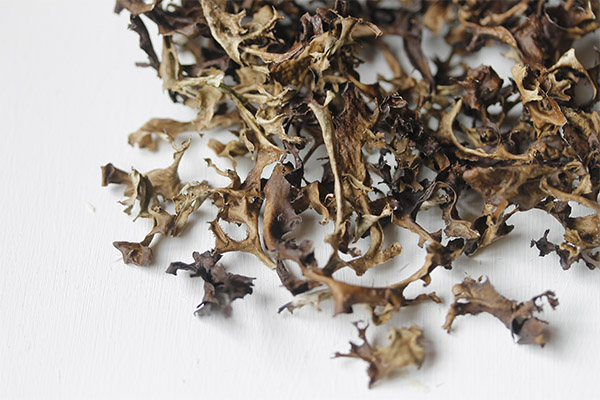
Infusion
In the treatment of diseases of the respiratory system, including severe, dangerous and chronic (such as bronchial asthma, tuberculosis, whooping cough and pneumonia), folk medicine offers as part of the complex therapy to use the infusion of Icelandic moss.
To prepare it, brew 2 teaspoons of dried lichen in a glass of boiling water and insist under a lid for half an hour. Take 1-2 tablespoons before meals, about 5-6 times a day. Treatment is better to 10-day courses, after which a break for 3-4 days, and then repeat the treatment. Take three courses.
The same infusion can also be used externally. Employees of logging organizations, far from civilization, have learned to use it successfully for the treatment of ulcers and purulent wounds. To make the wounds heal faster, they are washed and irrigated with the infusion of this lichen.
Tincture
Folk healers suggest taking an alcoholic tincture of Icelandic moss not only as a therapeutic agent, but also as a preventive. With the purpose of prevention tincture drink a course. In a year there should be two courses with a duration of two-three weeks each. Also, say herbalists, it is an indispensable tool for treating diseases of the gastrointestinal tract, improve appetite, getting rid of a strong, stuffy cough. To prepare a healing tincture of 40 g of moss poured into a glass of 60% alcohol. Insist the drug in a dark place for 7 days. Take 2 times a day: 1 tablespoon drop 10-15 drops diluted with water to the brim.
Decoction
- To restore the tone of the stomach. Put 750 ml of water on a small fire for half an hour, adding to it 3 tablespoons of dried moss. When the decoction cools, it will be like a kissel. Drink this entire dose of such a kissel at one time. Repeat the intake of decoction from 3 to 5 days.
- Universal decoction. Such a remedy is suitable for ingestion for any health problems, which can be solved by Icelandic moss. In addition, it can also be used externally - to lubricate the skin. You need to hold for 5 minutes in a water bath 2 cups of boiling water in which poured a tablespoon of dried lichen. After straining to drink 30 ml from 3 to 5 times a day.
- In cancer. This decoction is shown as an aid in the complex treatment of cancer and for the prevention of cancer problems. You will need celandine, St. John's wort, St. John's wort, Icelandic moss - these plants should be crushed and put in a spacious bowl in two parts. Add to the container taken in three parts and also crushed water pepper, plantain leaves and nettles. Pour in this dry mass of green tea - 100 parts. Stir all the herbs, take from there 4 teaspoons of the mixture, pour 1 liter of hot water. You will get a daily rate of decoction. Insist it for an hour, then strain and drink warm 4 times a day by the glass.
Tea .
Drink a cup of tea from cetraria is useful for colds, disorders of the gastrointestinal tract, bronchitis and asthma (outside the period of exacerbation). This healing drink will help restore appetite, spur the work of the body's defenses. It shows a restorative effect, so it will be very useful as a preventive measure. To prepare it, pour 0.5 liters of water in a small metal kettle 2 teaspoons of crushed cetraria. Place on the stove and boil on low heat for 10 minutes. Remove the kettle from the stove, wrap it and hold so for at least ¾ hour. You can drink like normal tea - several times a day in small cups.
Ointment
Ointments with Icelandic moss can be made as hydrophilic (that is, water-soluble), or on fat or on a more complex starch-glycerin base. Ointments on fat bases must be used quickly, as they tend to spoil. Water-soluble ones are essentially cooled and therefore have taken the consistency of broths. They create thin elastic films on the skin, which hold up quite well.
- Ointment-study for skin problems. To make a concentrated decoction of lichen is simple: pour 1 kg of crushed (you can not grind very much) cetraria for 1 liter of water. Boil for 15 minutes, cool. Apply to scratches, burns, cuts, and can be applied to pimples, acne, and other problem areas of the skin.
- Starch-glycerin-based ointment. Take 7 grams each of water and wheat starch, stir, add 93 grams of drugstore glycerin. Heated in a water bath with constant stirring until you get a light translucent homogeneous mass (its weight is 100 g). When it cools, for this amount add 1-1.5 teaspoons of Icelandic moss ground into dust and stir. The ointment is ready. It will be slowly absorbed, so it can effectively solve problems with vascular spiders, burns.
Syrup
In the autumn and winter period, when colds are not uncommon, syrup with Icelandic moss will help. It is used for coughs, and is prepared on the basis of an extract of cetraria, adding additional components. The extract is a rich mucilaginous decoction of the plant. It is mixed with honey or sugar. The result is a pleasant-tasting remedy with a high concentration of useful substances that can cure a cough in 7-10 days. Honey is more useful than sugar for preparing a cure, because it has antimicrobial properties. But it can not be given to children under two years of age.
Cough syrup
To prepare a syrup with Icelandic moss, you need to prepare a decoction: add 1 tablespoon of dry raw materials to 250 ml of water and boil for 15 minutes. Decoction strain hot, cool a little and stir with honey: 1 part broth take 3 parts honey. Heat the mixture in a water bath, stirring constantly, until the honey becomes quite liquid. The syrup is ready!
Pharmacy preparations with Icelandic moss
On the shelves of pharmacies there are many preparations made on the basis of Icelandic moss. About how to use it correctly and in what dosage, it is necessarily told in the instructions. Although these preparations are available without a prescription, before going to the pharmacy, you should ask your doctor's opinion on their use. The pharmacies also sell real dried lichen. It is packaged in cardboard boxes and can appear as just a dried medicinal plant or as a tea with the same name.
Under the name "Icelandic Moss" you can buy anti-inflammatory, antiseptic, warming and analgesic cream, which is indicated as an external remedy for skin injuries, bruises, sprains, wounds, colds, coughs, joint pain.
Men can buy vitamins "Men-s formula prostate forte", one of the components of which is a medicinal lichen. They are designed to normalize metabolic processes in the prostate gland, relieve inflammation and swelling of the prostate, eliminate discomfort and pain during urination.
But the largest group of preparations based on Icelandic moss are medicines for the treatment of bronchopulmonary diseases, colds and coughs. These are both syrups and tablets.
- Herbion syrup is used for dry coughs, dry mucous membranes and strains on the vocal cords. The drug can be given to children after one year of age.
- Syrup "Pectolvan C" treats acute and chronic respiratory diseases, effective in the formation of difficult to separate viscous sputum. It smells like strawberries. Not allowed in the first trimester of pregnancy because of the additional components contained in the drug.
- "Pectolvan fito" is a phytopreparation, an alcoholic extract. It is used in the form of drops that are dissolved in water before intake. More effective than the previous drug, but it is not allowed for children under 12 years of age.
- Isla Moos tablets. These are actually lozenges for sucking up. They are used for bronchitis, pharyngitis, laryngitis, and hoarseness of the voice. They are also useful for singers and lecturers - those people who have an increased load on the vocal cords. Can be given to children over 4 years of age.
- Bronchical Plus syrup for children. The name speaks for itself. In addition to Icelandic moss, enriched with vitamin C. Used for colds and flu, bronchitis.
- "Sodium usninat." In pharmacies sold in different forms: powder, oil and alcohol solutions, with glycerin or as part of a fir balsam. The powder can be taken internally, solutions and balm are used for external treatment of wounds, burns and cracked skin.
Cosmetic applications
Icelandic moss can be used for cosmetic purposes by everyone, the only contraindication here can be - individual intolerance. Rarely, it happens when the skin is hypersensitive to drugs based on cetraria. In this case, their use should be abandoned.

In general, this plant does not give side effects that can harm the human body. Moreover, its antibacterial and anti-inflammatory properties are indispensable for soothing skin irritation, very effective for getting rid of pimples, acne and against skin infections, work well for healing skin lesions - diaper rash, scratches, abrasions, burns and even wounds. The latter task is also helped with the inherent vasoconstrictor properties of Irish moss. This ability to "tighten" vessels is the basis of its application for reduction of so-called spider veins, or, in jargon, couperose, and for elimination of symptoms of some forms of chronic facial redness, or rosacea.
By getting rid of facial puffiness and removing bags from under the eyes, Irish moss works as an anti-inflammatory. Because of this same characteristic, the plant is used after wounds and cuts to reduce the formation of scar tissue. Because of the tannins in the plant, it is used to reduce inflammation of the gums and to care for the mouth.
The plant is used by pharmaceutical companies in the production of dermatological preparations and medicinal cosmetics to solve vascular problems and to get rid of inflammatory problems. Icelandic moss is also used in hair care products, deodorants and antiperspirants and in shower gels. In accordance with the regulations of the European Union, cetraria forms up to 5% of the ingredients of finished cosmetics.
Wraps
You can prepare at home useful for the skin composition, and then wrap them problem areas. You will need only 3 tablespoons of Icelandic moss, which should be brewed with a small amount of boiling water to get a pulp. It would be nice to add to it a little mint, as well as a couple of drops of orange or lemon oil (you can buy them at any drugstore). Apply the resulting composition to the skin, wrap it in clingfilm and lie quietly for an hour and a half. Then take a shower. Such wraps are effective for courses of 8-10 procedures. The skin becomes noticeably smoother, more even and elastic. Those who have used this method, note that the excess fluid comes out of the tissues, the body even decrease in volume.
Elixir for Youth
Most women dream of finding a recipe for a magic elixir that would allow them to stay young and beautiful for many years. The inhabitants of the harsh northern countries have long practiced for this reception composition of Icelandic moss. To prepare it, they would take 1.5 tablespoons of dried material, pour 0.5 liter of cold water and bring it to the boil, but do not boil, and immediately turn it off. Strain it after cooling and drink it three times a day.
For blackheads
You can fight acne by using decoction of Icelandic moss as an external remedy, rubbing it on problem areas, and internally. To do this, boil for 10 minutes in a glass of water over low heat 2 tablespoons of dry plant. Drink the resulting composition cold - half a glass 3 times a day before meals.
From dandruff
Brew 1 liter of steep boiling water and a third cup of dried Icelandic moss, let stand for about half an hour, strain. Add water to 3 liters. Rinse your hair after washing. If you do this procedure at least once a week, dandruff will soon disappear.
Cleansing Soap
Grate a bar of baby soap. Melt the chips in a water bath. While the soap is melting, make a broth of 0.5 cup milk and a handful of crushed dry cetraria, pour the broth into the melted soap shavings and stir. Take silicone forms for baking cakes and pour the resulting mixture into them, adding a couple of drops of essential oil and glycerin. If you are not sure of the quality of the product, you must use it in the same way as in the same day. When cooled, it can be used to cleanse the skin.
Contraindications for use
There are not many contraindications to the use of oral medications and folk potions on the basis of cetraria Icelandica. You should not drink such remedies if the body temperature rose above 39 degrees, as well as in exacerbations of chronic diseases such as cholecystitis, pancreatitis, ulcerative colitis and bronchial asthma. Do not use them for people suffering from peptic ulcer disease and gastritis with hyperacidity, liver abnormalities.

But even if a person does not have these contraindications, it is necessary to remember that it is not recommended to be too zealous with the reception of means of Icelandic moss. Experimentally proved that the daily intake of 0.1-1 g of sodium usninat contained in the plant has no negative impact. When the dose was increased to 3 g, pain occurred in the liver area. When the dose was reduced, the pain ceased.
Children under one year of age should not be given Icelandic moss products internally. Externally, these treatments are harmless.
In addition, we must not forget that the treatment by lichen alone is not possible. It is necessary to combine taking remedies on its basis with the treatment prescribed by the doctor, especially in such severe diseases as pneumonia, tuberculosis, cancer.
«Important: All information on the site is provided solely for introductory purposes only. Consult a doctor before applying any recommendations. specialist. Neither the editors nor the authors shall be liable for any possible harm caused by materials."

